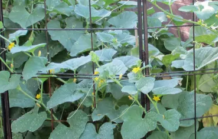Watermelon is a native crop of Africa that grows well in the warm dry days of Kansas summers. The plant grows best in deep sandy soils; however, small icebox-type watermelons can be grown on upland shallow soils. Watermelons require a lot of room and are not well adapted to small backyard gardens.
Varieties
Round or elongated striped varieties include Crimson Sweet, Royal Sweet, Royal Jubilee, Mirage, Oasis, Allsweet and Calsweet. Round dark green varieties include Blackstone and Blue Bell. Elongated light green varieties include Sweet Princess, Summer Flavor, and Prince Charles. Icebox types include Sugar Baby, Gold Baby (yellow), Mickeylee, and Minilee. King of Hearts is a good seedless variety.
When to plant
Watermelons thrive in warm soils and planting after all danger of frost is past in early to mid-May is recommended.
Spacing
Standard watermelons require about 50 square feet per plant or hill–2-3 plants together. Plant 4-5 feet apart in rows 10-12 feet apart. Small-vined icebox varieties can be spaced closer together, using 2-3 feet between hills in rows 5-6 feet apart. Plant seeds about an inch deep.
Care
Watermelons need a warm, sunny, well-drained growing area. Weeds are difficult to control in sprawling vines, making early season weed control essential. Scrape weeds
using shallow cultivation close to the plants. Watermelons can be grown as a transplant and transferred to the garden. Use a fairly large transplant or peat pot container for best results.
Like cucumbers, muskmelon, squash, and pumpkin, watermelons have separate male and female flowers on the same plant. Bees are necessary to transfer pollen from the male to female flowers, so use insecticides carefully around these crops.
Harvesting
Watermelons are ready for harvest when the underside of the fruit turns a bright buttery yellow color and when the small curled tendril where the fruit attaches to the vine has turned brown and died. Thumping larger fruited varieties produces a dull hollow sound when ripe; however, small icebox types are difficult to thump to determine ripeness.
Common concerns
Cucumber beetles Aphids
Brand names appearing in this publication are for product identification purposes only. No endorsement is intended, nor is criticism implied of similar products not mentioned.





Do you have images or seed for Mirage watermelons?